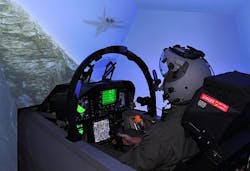Australian navy buys L-3 Link flight simulators for EA-18G pilot training and mission rehearsal
ORLANDO, Fla., 17 Oct. 2014. U.S. Navy simulation and training experts are asking the L-3 Communications Corp. Link Simulation & Training segment in Arlington, Texas, to build simulation, training, and mission rehearsal equipment for Australian navy EA-18G Growler electronic warfare jet aircraft crews.
Officials of the Naval Air Warfare Center Training Systems Division in Orlando, Fla., are awarding a $12.1 million order to L-3 Link to provide two EA-18G tactical operational flight trainers, one brief/debrief station, two F/A-18 retrofit kits, spare parts, and documentation for the Royal Australian Navy under the foreign military sales program.
The latest generation of EA-18G flight simulators are integrated with L-3 Link's SimuSphere visual system display. SimuSphere is a dodecahedron-shaped visual system display that provides equally high visual scene brightness and resolution across all of its same-sized pentagonal facets.
Related: Aero Simulation chooses projectors from Christie for Marine Corps AH-1W flight simulator
F/A-18 tactical operational flight trainers also are integrated with L-3 Link's SimuView personal computer image generation system, which provides both out-the-window and sensor imagery.
The EA-18G tactical operational flight trainer helps pilots in field to practice carrier takeoffs and landings, low altitude flight, air-to-air and air-to-ground weapons delivery, electronic countermeasures, and emergency procedures.
Simulator operators can vary the offensive and defensive skill level of the simulated adversaries as pilots develop and refine their air-to-air combat skills on the trainer.
Related: Global military simulation and training market trending stable to downward through 2022
L-3 Link simulator designers also are networking EA-18G operational flight trainers to other simulators to enable several air crews to conduct tactical combat training against common, simulated threats.
These flight simulators have been delivered to the U.S. Navy, U.S. Marine Corps, and international military services, in addition to the Australian navy. On this contract L-3 Link will do the work in Arlington, Texas, and should be finished by November 2015.
For more information contact L-3 Link Simulation & Training online at www.link.com, the Naval Air Warfare Center Training Systems Division at www.navair.navy.mil/nawctsd, or the Royal Australian Navy at www.navy.gov.au.

John Keller | Editor
John Keller is editor-in-chief of Military & Aerospace Electronics magazine, which provides extensive coverage and analysis of enabling electronic and optoelectronic technologies in military, space, and commercial aviation applications. A member of the Military & Aerospace Electronics staff since the magazine's founding in 1989, Mr. Keller took over as chief editor in 1995.



